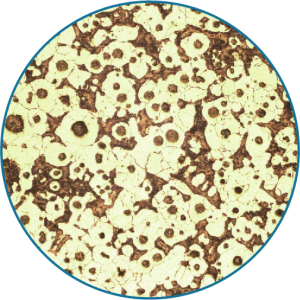What is S.G (Spheroidal Graphite) Iron?
Developed in 1943, it was found that by adding magnesium before pouring caused the graphite to form nodules rather than flakes. This resulted in a new material, with excellent tensile strength and ductility. Adding these mechanical properties of this material to the advantages already offered by cast iron soon led to it finding its way into virtually every mainstream area of engineering. In many cases replacing existing steel castings or forgings due to achievable cost savings.

The Microstructure of S.G. Iron
Properties:
Strength
Tensile strengths of up to 900N/mm2 (ADI gives the option of higher strengths).
Ductility
Elongations of in excess of 20% (Lower grades only)
Excellent Corrosion Resistance
When compared to other ferrous metals.
Free graphite in the structure also lends itself to machining (chip formation).
Significantly cheaper than most materials.
| Mechanical Properties | |||
| Grade | Tensile Strength (RM) N/mm² min | 0.2% proof stress (Rp0.2) N/mm² min | Elongation (A) % min |
| EN-GJS-400-18-LT1) | 400 | 240 | 18 |
| EN-GJS-400-18-RT1) | 400 | 250 | 18 |
| EN-GJS-400-18 | 400 | 250 | 18 |
| EN-GJS-400-15 | 400 | 250 | 15 |
| EN-GJS-450-10 | 450 | 310 | 10 |
| EN-GJS-500-7 | 500 | 320 | 7 |
| EN-GJS-600-3 | 600 | 370 | 3 |
| EN-GJS-700-2 | 700 | 420 | 2 |
| EN-GJS-800-2 | 800 | 480 | 2 |
| EN-GJS-900-2 | 900 | 600 | 2 |
| 1) LT = Low Temperature | |||
| 2) RT = Room Temperature | |||
